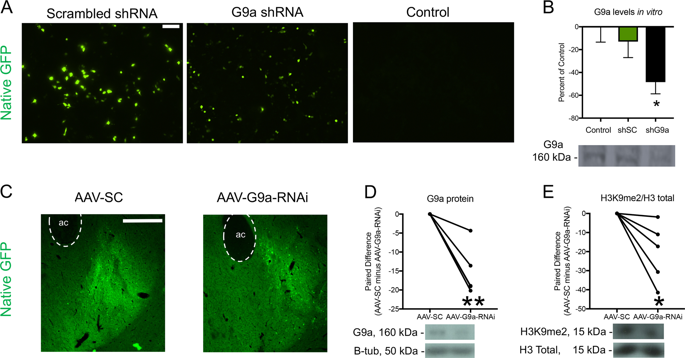当前位置:
X-MOL 学术
›
Neuropsychopharmacology
›
论文详情
Our official English website, www.x-mol.net, welcomes your feedback! (Note: you will need to create a separate account there.)
Knockdown of the histone di-methyltransferase G9a in nucleus accumbens shell decreases cocaine self-administration, stress-induced reinstatement, and anxiety.
Neuropsychopharmacology ( IF 7.6 ) Pub Date : 2018-12-26 , DOI: 10.1038/s41386-018-0305-4 Ethan M Anderson 1, 2 , Haosheng Sun 3 , Daniel Guzman 1 , Makoto Taniguchi 2 , Christopher W Cowan 2 , Ian Maze 3 , Eric J Nestler 3 , David W Self 1
Neuropsychopharmacology ( IF 7.6 ) Pub Date : 2018-12-26 , DOI: 10.1038/s41386-018-0305-4 Ethan M Anderson 1, 2 , Haosheng Sun 3 , Daniel Guzman 1 , Makoto Taniguchi 2 , Christopher W Cowan 2 , Ian Maze 3 , Eric J Nestler 3 , David W Self 1
Affiliation

|
Comorbid neuropsychiatric disorders such as addiction and anxiety could involve common underlying mechanisms. One potential mechanism involves epigenetic regulation of histone 3 dimethylation at lysine 9 residues (H3K9me2) by the histone dimethyltransferase G9a. Here we provide evidence that local AAV-RNAi-mediated knockdown of G9a expression in nucleus accumbens shell (NAcSh) of male rats reduces both addictive-related and anxiety-related behaviors. Specifically, G9a knockdown reduces sensitivity to low dose cocaine reinforcement when cocaine is freely available (fixed ratio schedule). Similarly, G9a knockdown reduces motivation for cocaine under higher effort demands (progressive ratio schedule). Following several weeks of forced abstinence, G9a knockdown attenuates extinction responding and reinstatement triggered by either cocaine-priming injections or footshock stress. This decrease in addictive behavior is associated with a long-term reduction in anxiety-like behavior as measured by the elevated plus maze (EPM). G9a knockdown also reduces basal anxiety-like behavior in EPM and marble burying tests in drug-naïve rats. These results complement our previous work showing that increased G9a expression in NAcSh enhances addictive-related and anxiety-related behaviors, indicating that G9a bi-directionally controls these responses. These results also suggest that regulation of G9a-influenced gene expression could be a common epigenetic mechanism for co-morbid anxiety and psychostimulant addiction.
中文翻译:

敲除伏隔核壳中的组蛋白二甲基转移酶 G9a 可减少可卡因的自我给药、压力诱导的恢复和焦虑。
成瘾和焦虑等共病神经精神疾病可能涉及常见的潜在机制。一种潜在的机制涉及组蛋白二甲基转移酶 G9a 在赖氨酸 9 残基 (H3K9me2) 处对组蛋白 3 二甲基化的表观遗传调控。在这里,我们提供证据表明局部 AAV-RNAi 介导的雄性大鼠伏隔核壳 (NAcSh) 中 G9a 表达的敲低减少了成瘾相关和焦虑相关的行为。具体来说,当可卡因免费提供时,G9a 敲低降低了对低剂量可卡因强化的敏感性(固定比例时间表)。类似地,G9a 击倒降低了在更高的努力需求下(渐进比率计划)的可卡因动机。经过数周的强制禁欲后,G9a 敲低减弱了由可卡因启动注射或足部电击压力引发的灭绝反应和恢复。这种成瘾行为的减少与通过高架十字迷宫 (EPM) 测量的焦虑样行为的长期减少有关。G9a 敲低还减少了 EPM 和大理石掩埋试验中未用药大鼠的基础焦虑样行为。这些结果补充了我们之前的工作,表明 NAcSh 中 G9a 表达的增加增强了成瘾相关和焦虑相关的行为,表明 G9a 双向控制这些反应。这些结果还表明,受 G9a 影响的基因表达的调节可能是共病焦虑和精神兴奋剂成瘾的常见表观遗传机制。这种成瘾行为的减少与通过高架十字迷宫 (EPM) 测量的焦虑样行为的长期减少有关。G9a 敲低还减少了 EPM 和大理石掩埋试验中未用药大鼠的基础焦虑样行为。这些结果补充了我们之前的工作,表明 NAcSh 中 G9a 表达的增加增强了成瘾相关和焦虑相关的行为,表明 G9a 双向控制这些反应。这些结果还表明,受 G9a 影响的基因表达的调节可能是共病焦虑和精神兴奋剂成瘾的常见表观遗传机制。这种成瘾行为的减少与通过高架十字迷宫 (EPM) 测量的焦虑样行为的长期减少有关。G9a 敲低还减少了 EPM 和大理石掩埋试验中未用药大鼠的基础焦虑样行为。这些结果补充了我们之前的工作,表明 NAcSh 中 G9a 表达的增加增强了成瘾相关和焦虑相关的行为,表明 G9a 双向控制这些反应。这些结果还表明,受 G9a 影响的基因表达的调节可能是共病焦虑和精神兴奋剂成瘾的常见表观遗传机制。这些结果补充了我们之前的工作,表明 NAcSh 中 G9a 表达的增加增强了成瘾相关和焦虑相关的行为,表明 G9a 双向控制这些反应。这些结果还表明,受 G9a 影响的基因表达的调节可能是共病焦虑和精神兴奋剂成瘾的常见表观遗传机制。这些结果补充了我们之前的工作,表明 NAcSh 中 G9a 表达的增加增强了成瘾相关和焦虑相关的行为,表明 G9a 双向控制这些反应。这些结果还表明,受 G9a 影响的基因表达的调节可能是共病焦虑和精神兴奋剂成瘾的常见表观遗传机制。
更新日期:2019-01-26
中文翻译:

敲除伏隔核壳中的组蛋白二甲基转移酶 G9a 可减少可卡因的自我给药、压力诱导的恢复和焦虑。
成瘾和焦虑等共病神经精神疾病可能涉及常见的潜在机制。一种潜在的机制涉及组蛋白二甲基转移酶 G9a 在赖氨酸 9 残基 (H3K9me2) 处对组蛋白 3 二甲基化的表观遗传调控。在这里,我们提供证据表明局部 AAV-RNAi 介导的雄性大鼠伏隔核壳 (NAcSh) 中 G9a 表达的敲低减少了成瘾相关和焦虑相关的行为。具体来说,当可卡因免费提供时,G9a 敲低降低了对低剂量可卡因强化的敏感性(固定比例时间表)。类似地,G9a 击倒降低了在更高的努力需求下(渐进比率计划)的可卡因动机。经过数周的强制禁欲后,G9a 敲低减弱了由可卡因启动注射或足部电击压力引发的灭绝反应和恢复。这种成瘾行为的减少与通过高架十字迷宫 (EPM) 测量的焦虑样行为的长期减少有关。G9a 敲低还减少了 EPM 和大理石掩埋试验中未用药大鼠的基础焦虑样行为。这些结果补充了我们之前的工作,表明 NAcSh 中 G9a 表达的增加增强了成瘾相关和焦虑相关的行为,表明 G9a 双向控制这些反应。这些结果还表明,受 G9a 影响的基因表达的调节可能是共病焦虑和精神兴奋剂成瘾的常见表观遗传机制。这种成瘾行为的减少与通过高架十字迷宫 (EPM) 测量的焦虑样行为的长期减少有关。G9a 敲低还减少了 EPM 和大理石掩埋试验中未用药大鼠的基础焦虑样行为。这些结果补充了我们之前的工作,表明 NAcSh 中 G9a 表达的增加增强了成瘾相关和焦虑相关的行为,表明 G9a 双向控制这些反应。这些结果还表明,受 G9a 影响的基因表达的调节可能是共病焦虑和精神兴奋剂成瘾的常见表观遗传机制。这种成瘾行为的减少与通过高架十字迷宫 (EPM) 测量的焦虑样行为的长期减少有关。G9a 敲低还减少了 EPM 和大理石掩埋试验中未用药大鼠的基础焦虑样行为。这些结果补充了我们之前的工作,表明 NAcSh 中 G9a 表达的增加增强了成瘾相关和焦虑相关的行为,表明 G9a 双向控制这些反应。这些结果还表明,受 G9a 影响的基因表达的调节可能是共病焦虑和精神兴奋剂成瘾的常见表观遗传机制。这些结果补充了我们之前的工作,表明 NAcSh 中 G9a 表达的增加增强了成瘾相关和焦虑相关的行为,表明 G9a 双向控制这些反应。这些结果还表明,受 G9a 影响的基因表达的调节可能是共病焦虑和精神兴奋剂成瘾的常见表观遗传机制。这些结果补充了我们之前的工作,表明 NAcSh 中 G9a 表达的增加增强了成瘾相关和焦虑相关的行为,表明 G9a 双向控制这些反应。这些结果还表明,受 G9a 影响的基因表达的调节可能是共病焦虑和精神兴奋剂成瘾的常见表观遗传机制。


























 京公网安备 11010802027423号
京公网安备 11010802027423号